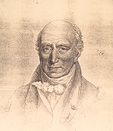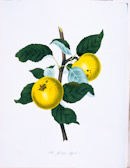thomas
andrew knight
Archive of Cider Pomology Home
Thomas Andrew Knight, was an 18th century horticulturalist, who helped to develop many of the fruit and vegetable varieties that we still eat today. He wrote the original ‘Pomona Herefordiensis’ and later went on to become president of the London Horticultural Society (which later became the Royal Horticultural Society).
and vegetable varieties that we still eat today. He wrote the original ‘Pomona Herefordiensis’ and later went on to become president of the London Horticultural Society (which later became the Royal Horticultural Society).
Thomas Andrew Knight is credited by Darwin in the first chapter of ‘The Origin of Species’ for his pioneering work on the origin of cultivated plants. It is also believed that Knight’s observations on the results of breeding work with peas may have influenced Mendel to use peas for the basis of his important studies into inheritance, but many people do not realise that he was born and spent much of his life in Herefordshire.
Horticultural work begins in Herefordshire
Thomas Andrew Knight was born in Herefordshire at Wormsley Grange and spent his life amidst orchards.
He was the youngest son of the Reverend Thomas Knight and it can be presumed that after his education at Oxford University at Balliol College he was intended to enter the church. However, he left Oxford without taking a degree to return to Herefordshire to live as a country gentleman following rural pursuits.
The Knight family included his grandfather, Richard Knight, who established a prosperous iron working industry in the Coalbrookdale area. Thomas Andrew inherited the means to live as a country gentleman and allow him to engage in his enquiries about some scientific aspects of horticulture.
Knight’s scientific work really commenced in earnest in the gardens at Elton Hall near Ludlow where he moved after his marriage to Frances Felton in 1791. Later he moved to Downton Castle overlooking the River Teme, after his brother Richard Payne moved to London in 1809, and continued his scientific horticultural work there.
He achieved several important pieces of scientific work. The introduction of controlled plant breeding for the improvement of fruits and other domesticated plants was particularly significant. He described his methodology in 1797 in his Treatise on the Culture of the Apple and Pear which was published in five editions. His experimental demonstration that gravity has an influence on the growth of plants was recognised by the Royal Society by the award of the Copley Gold medal in 1806. He had been elected as a Fellow of the Royal Society in 1805 in recognition of his contributions to science.
Through his friendship with Sir Joseph Banks, President of the Royal Society, he became a Founder Member of the of Horticultural Society London (now the Royal Horticultural Society) in 1804. He was elected as its second President in 1811. This was an eventful year as his Pomona Herefordiensis was published in 1811 and thus there is a double celebration in 2011.
Cultivation of new plant varieties
 Thomas
Andrew Knight introduced controlled pollination for plant breeding in the late
eighteenth century. His interest was aroused by his observation that new types
were needed for fruit orchards to replace existing varieties. The earliest
recorded introduction into cultivation of a new variety was that of the ‘Grange’
apple in 1792.
Thomas
Andrew Knight introduced controlled pollination for plant breeding in the late
eighteenth century. His interest was aroused by his observation that new types
were needed for fruit orchards to replace existing varieties. The earliest
recorded introduction into cultivation of a new variety was that of the ‘Grange’
apple in 1792.
The methodology for his work was recorded in his book Treatise
on the Culture of the Apple and Pear published
in 1797. During his lifetime Knight produced a range of new varieties of fruits
some of which are still in cultivation today including ‘Downton Pippin’ apple
and ‘Waterloo’ cherry. His plant breeding extended to other crop plants and
particularly peas, strawberries, pears, potatoes, plums and nectarines.
Knight’s use of controlled pollination was quickly taken up by other plant
breeders in Britain and overseas. He sent propagating material overseas and
especially significant was the gratuitous donation varieties through the
Massachusetts Agricultural Society and these were then disseminated through the
North East of the USA.
Knight was a meticulous observer of his experimental plant breeding. In his
records of the results of his crossings of different forms of the garden pea the
inheritance of traits is noted and these were confirmed and developed by the
later work of Gregor Mendel in the mid-nineteenth century.
A report on observations from his breeding of strawberries was published by the
Linnean Society in 1818. The report showed that Knight had determined three
compatibility groups for breeding and this has been confirmed in the twentieth
century as due to the genetics involving chromosome numbers.
Plant physiology was a subject which engaged the attention of Knight and his
greatest success was the experimental demonstration that gravity affected the
direction of growth of shoots and roots of Broad Bean seedlings. His
experimental apparatus was a water wheel constructed on the stream by his garden
at Elton Hall and this was illustrated by Sir Humphry Davy in 1813 in his book Elements
of Agricultural Chemistry.
Archive of Cider Pomology Home
 Thomas
Andrew Knight introduced controlled pollination for plant breeding in the late
eighteenth century. His interest was aroused by his observation that new types
were needed for fruit orchards to replace existing varieties. The earliest
recorded introduction into cultivation of a new variety was that of the ‘Grange’
apple in 1792.
Thomas
Andrew Knight introduced controlled pollination for plant breeding in the late
eighteenth century. His interest was aroused by his observation that new types
were needed for fruit orchards to replace existing varieties. The earliest
recorded introduction into cultivation of a new variety was that of the ‘Grange’
apple in 1792. and vegetable varieties that we still eat today. He wrote the original ‘Pomona Herefordiensis’ and later went on to become president of the London Horticultural Society (which later became the Royal Horticultural Society).
and vegetable varieties that we still eat today. He wrote the original ‘Pomona Herefordiensis’ and later went on to become president of the London Horticultural Society (which later became the Royal Horticultural Society).